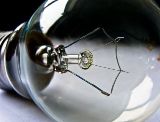How to replace a burnt out lamp
The article describes the possible risks when replacing lighting lamps and the simplest rules for safe work with electricity.
 Let's start with the rules: to work on electrical networks, at least three people are needed: one supervisor, who does not have the right to participate in the execution of the work, and two people - this is the minimum composition of the team performing the work. Funny? But the rules are written on the "bones" of those who broke them.
Let's start with the rules: to work on electrical networks, at least three people are needed: one supervisor, who does not have the right to participate in the execution of the work, and two people - this is the minimum composition of the team performing the work. Funny? But the rules are written on the "bones" of those who broke them.
A common situation: in the evening you enter the room, feel the switch in the usual place, press it, and a bright flash suggests that another light bulb has ended its "mortal" life in your apartment. Then there are two options: run to the store for a new bulb if it's still open; or pull a new light bulb from your household supplies. The technology for further work is standard: unscrew the burnt one, screw in a new one, check it and all problems are solved: what can we talk about next?
And let's talk about the words "twist" and "twist".You stand on a chair, if the height of the room or your height does not allow you to work comfortably, remove the burned out lamp. But, as luck would have it, the lamp bulb detaches, leaving the base in the socket. You don't need to mention that you turned off the lights in the room beforehand—it's a common precaution.
 Remembering the manufacturer with an unkind word, take a suitable tool, catch the rest of the base in the cartridge and ... a noticeable electric shock confirms that today you are definitely out of luck. The option "... wake up - a plaster cast" will not be considered rather rare and gloomy, but rather will understand why it happened.
Remembering the manufacturer with an unkind word, take a suitable tool, catch the rest of the base in the cartridge and ... a noticeable electric shock confirms that today you are definitely out of luck. The option "... wake up - a plaster cast" will not be considered rather rare and gloomy, but rather will understand why it happened.
The light switch must necessarily open the live wire (phase). But there may be options: either a «crooked» electrician confused with a wire when wiring, or a «fashionable» switch with light illumination is installed in your room. In any case, there will be a voltage of 220 volts on the cartridge. The phase wire is usually connected to the center contact of the socket. You need to find out all this before starting work, using the voltage indicator available in the tool kit intended for electrical work.
Another problem may occur when replacing: a new bulb does not light up when turned on. The reason is simple: in the chuck, the center contact, which should be made of spring bronze, is now usually made of brass. Therefore, one more simple operation must be done: bend the contact for a reliable connection with the base of the lamp.But without a suitable tool and confidence that there is no voltage on the cartridge, it is better to postpone these manipulations for the next day, when it will be light and you can turn off the electricity in the entire apartment.
If we take into account the low quality of incandescent lamps, overvoltage in the network and other reasons affecting the service life of incandescent lamps, then the manipulations described above should be carried out quite often. Therefore, try to listen to the recommendations of a person who has worked with electricity for most of his life:
1. Be extremely careful when doing any electrical work! Remember the rule: "Electricity is a good servant, but a very bad master."
2. See point one.
— .
